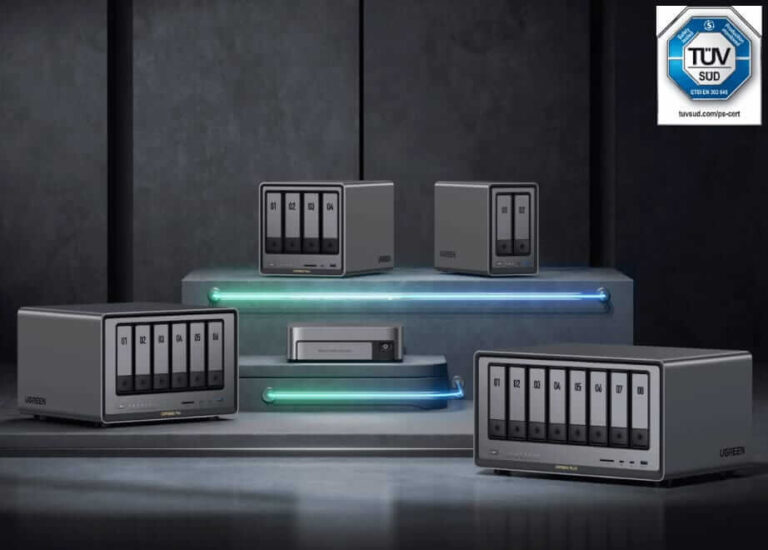Security Advantages of NAS Server in Local Environments
Network-attached storage devices excel in confining data to physical premises, thereby limiting exposure to widespread threats that target remote infrastructures. Administrators enforce strict access protocols without intermediary dependencies, ensuring files remain shielded from external probes. Recent analyses confirm that properly configured NAS servers surpass cloud alternatives in user-directed defenses, as control stays centralized and uncompromised. Encryption at the hardware level, combined with firewall integrations, fortifies against intrusions, while RAID configurations provide redundancy against hardware failures.
This foundation allows for customized vigilance, such as scheduling automated backups to secondary drives, which operate offline to evade network-based attacks. Professionals in fields like legal services or healthcare find these measures essential for compliance, as they align precisely with standards demanding on-site retention. Home users, too, benefit from simple setups that integrate with existing routers, yielding robust protection without advanced expertise.
Transitioning to daily application proves straightforward: connect the NAS server to the local network, install management software, and define user hierarchies. Such steps not only enhance safety but also streamline retrieval, as data transfers occur at gigabit speeds free from bandwidth caps. Over months of use, this approach reveals fewer vulnerabilities, as updates apply directly without service-wide disruptions.
Privacy Risks Associated with Cloud Storage Platforms
Cloud environments, despite layered protections, expose data to third-party access and jurisdictional variances, amplifying breach potentials. Providers maintain vast repositories that attract sophisticated adversaries, with incidents revealing sensitive records across millions of accounts. In 2024, over 60% of organizations encountered public cloud-related security events, underscoring persistent gaps in perimeter defenses. Average breach costs reached $4.44 million in 2025, reflecting escalation in remediation and regulatory fines.
These platforms often scan content for compliance or optimization, inadvertently compromising confidentiality for users handling proprietary materials. Legal demands in host countries can compel disclosures, a factor absent in local setups. For creators managing intellectual property or families preserving personal archives, such exposures erode trust, prompting shifts toward self-managed solutions.
Mitigation efforts, like enabling zero-knowledge encryption, demand vigilant monitoring of policy updates, yet lapses persist due to human oversight. Enterprises report that 80% faced serious cloud issues in recent years, with servers targeted in 90% of cases. This pattern highlights the inherent trade-off: convenience versus autonomy.
Practical countermeasures include segmenting data uploads to non-critical files only, paired with frequent audits of access logs provided by the service. Still, these pale against the absolute containment of on-premises storage, where no external entity holds sway.

Comparative Analysis of NAS Server and Cloud Safety Metrics
Evaluating safety requires balancing accessibility against containment, where NAS servers consistently edge out clouds in privacy retention. Local systems eliminate transmission risks, as files never leave the premises, contrasting with cloud uploads vulnerable to interception en route. Studies from 2025 position NAS as superior for controlled environments, offering granular permissions that clouds approximate through shared models. Breach statistics further tilt the scale: while clouds report 27% of incidents yielding data losses, NAS incidents stem primarily from misconfigurations, resolvable on-site.
Performance metrics reinforce this: NAS delivers uninterrupted access during outages, immune to provider downtimes that affected global services in prior quarters. Cost analyses reveal long-term savings, as NAS avoids escalating subscription fees tied to storage tiers, freeing resources for enhanced safeguards like biometric locks.
Users in collaborative settings appreciate NAS’s role-based controls, which prevent over-sharing common in cloud folders. For scalability, NAS expands via additional bays, maintaining security uniformly, unlike clouds where growth invites broader attack surfaces.
This comparison equips decision-makers with criteria: prioritize NAS for irreplaceable assets, reserving clouds for disposable backups. Hybrid models emerge as viable, syncing select data outward while anchoring primaries locally.
Establishing a Private Cloud for Home via NAS Server
A private cloud for home leverages NAS servers to replicate cloud functionalities within secure boundaries, granting seamless access minus external dependencies. Dedicated applications enable remote syncing from mobiles or laptops, all routed through encrypted tunnels to preserve integrity. This arrangement suits households coordinating documents or streaming libraries, as it confines interactions to trusted networks.
Setup commences with firmware installation and drive population, followed by app pairings across devices. Features like dynamic DNS facilitate external connections, secured by multi-factor verifications to repel unauthorized attempts. Families configure shared volumes with tiered privileges, ensuring adolescents reach educational files without full visibility.
Enhanced protections include snapshot tools for versioning, countering malware that evades cloud filters. Integration with home ecosystems, such as linking to surveillance feeds, centralizes management without inviting platform intermediaries. Scalability accommodates evolving needs, from initial terabyte allocations to multi-petabyte arrays, all under unified oversight.
Maintenance routines involve quarterly firmware checks and drive diagnostics, far less intrusive than cloud password rotations. This private cloud for home fosters independence, aligning storage with daily patterns while upholding stringent safety.
Practical Implementation Strategies for NAS Security
Deploying NAS servers demands deliberate configurations to maximize safety, starting with physical placement in ventilated, access-restricted areas. Initial hardening encompasses disabling unused ports and enabling automatic updates, practices that thwart 70% of common exploits. Users select models with Intel processors for efficient encryption, ensuring overhead remains negligible during operations.
Backup protocols form the next layer: mirror critical data to external drives or secondary NAS units, tested monthly for integrity. For remote needs, VPN integrations simulate local sessions, bypassing public Wi-Fi hazards. Small teams implement audit trails to track modifications, aiding swift anomaly detection.
Cost-effective expansions utilize compatible drives from reputable brands, avoiding mismatches that invite failures. Training on dashboard navigation empowers non-technical users, reducing error-induced risks. Real-world deployments in creative industries demonstrate 50% faster recoveries post-incident, attributed to localized controls.
These strategies transform NAS from mere storage into a fortified repository, adaptable to varying scales.
Long-Term Sustainability of Local Storage Choices
Enduring viability defines effective storage, with NAS servers demonstrating resilience through modular designs and community-supported software. Components withstand years of continuous duty, outlasting cloud contracts prone to term alterations. Privacy endures as data sovereignty persists, immune to provider acquisitions that reshuffle policies.
Environmental monitoring tools alert to potential degradations, enabling preemptive swaps that preserve continuity. In contrast, cloud migrations disrupt workflows, incurring hidden costs in reformatting and verification. NAS users report sustained performance, with throughput holding steady as volumes grow.
For archival purposes, like preserving generational records, this stability ensures accessibility without format obsolescence. Enterprises leverage NAS for regulatory adherence, as audits confirm unchallenged chains of custody.
Overall, local storage via NAS servers proves safer for those valuing control, delivering verifiable protections amid rising threats. Clouds suit transient needs, but for core holdings, on-premises command prevails. Assess volumes and access patterns to select optimally, securing futures through deliberate choices.







